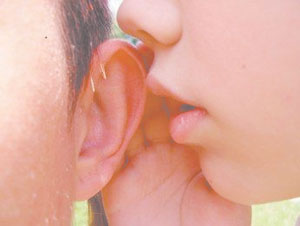May 5, 2010
Hearing Better: Positive Communication Strategies
 PICS – Parker, Molly.epsBy Dr. Molly Parker
PICS – Parker, Molly.epsBy Dr. Molly Parker
Audiologist
Don White Hearing Aid Center
Communication is a two way street: the talker and listener each have a responsibility. The talker must speak loud and clear, and present their ideas in an orderly way. The listener’s job is to pay attention and speak up if something is not understood. If one person does not perform their job, then the message gets mixed up. Hearing aids make your job listening much easier. In some cases other assistive devices that can work with your hearing aids to further remove background noise.
Remember, if there is something you can do to improve your listening situation, you will feel more involved and active in your life. Most of the time, these simple suggestions can help. It may help to frequently and (nicely) remind the other person to speak a little differently. Or, you can be a gracious listener and provide cues that you understood the other person.

For the normal hearing person:
1. Get the other person’s attention. If necessary tell them what the topic is before talking about it.
2. Turn off background noise. TV, radio, shut the door, etc.
3. Look at the other person-make sure they can see you.
4. Smile and talk slowly. Shouting distorts. If necessary, “chunk” your
phrases. For example, “Today…. I am going…. to the store…..to buy some…milk.”
5. Rephrase rather than repeat. Say the message more slowly.
6. Hearing aids do not replace normal hearing-they amplify your voice and remove extra noise so you do not have to shout. They make listening
easier but not normal for the user.
For the hearing impaired:
1. Try to improve your listening situation. It is not your fault you cannot hear well. However, you can make it easier for others to talk to you. Ask
others to talk louder, slower, clearer, look at you, turn off the TV, get a
little closer, etc.
2. Communication habits are hard to break. Nicely remind others frequently how to speak, even if it is every 30 seconds. Again, the speaker’s job is to make themselves heard.
3. Look at others when they talk! Their facial expressions offer good
information and can help you understand.
4. Respond when others talk. Say, “OK,” nod your head, ask questions, etc. Others don’t know if you heard them or not.
5. If you have hearing aids, wear them as much as possible–even if it is quiet in your home. If there is a problem, take charge: see your audiologist, speak out, get a second opinion, ask others to help you. Hearing aids often require adjustments over time. There is no such thing as a one-size fits all hearing aid. If you are honest and willing, help is available.
Filed Under: Health & Wellness
Tags: Aids, Assistive Devices, Audiologist, Background Noise, Center Communication, Chunk, Communication Habits, Communication Strategies, Cues, Don White, Eps, Hearing Aid Center, Hearing Aids, Listener, Molly Parker, Noise Tv, Phrases, Rephrase, Simple Suggestions, Tv Radio
Trackback URL: https://www.50pluslife.com/2010/05/05/hearing-better-positive-communication-strategies/trackback/


